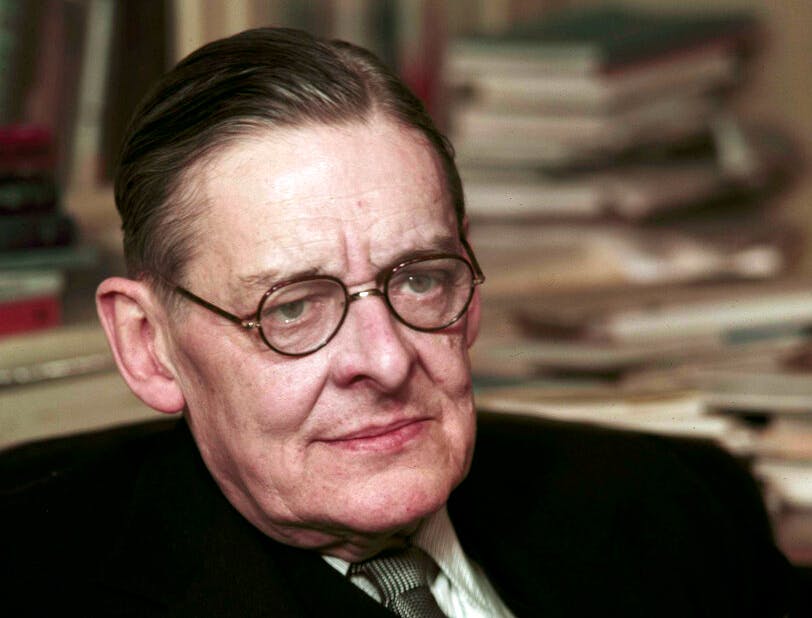When It Comes To Writing the Life of a Great Poet, Who Qualifies?
To be rejected as an outsider outraged T.S. Matthews, so he decided to write a book about the experience of doing T.S. Eliot’s biography.

‘Writing Great Tom: T.S. Eliot & the Keepers of the Flame’
By T.S. Matthews
Foreword by Sara Fitzgerald
Afterword by Karen Christensen
Berkshire Publishing, 233 pages
In the Foreword to T.S. Matthews’s 1974 biography of T.S. Eliot, “Great Tom,” the author quotes Eliot’s 1956 declaration that he saw no reason why “biographies of poets should not be written. They are very useful. Any critic seriously concerned with a man’s work should be expected to know something about the man’s life.”
After making that declaration, Eliot got married for a second time, in 1957, and left instructions prohibiting a biography. After he died in 1965 his widow, Valerie, closed his archive. His publisher, Faber & Faber, stood by to deny biographers permission to quote from Eliot’s published and unpublished writing.
Then, in the February 20, 1972, Observer, Valerie Eliot announced that the “right” biographer would be hard to find: “He must have a real understanding of the American background, in addition to knowing England and Europe. Ideally he should be able to sympathize with my husband’s religious outlook, and above all, he must have empathy.”
That sounded like T.S. Matthews, a Midwesterner, Anglo-Catholic, living in England with an Englishwoman, widely traveled in Europe, a member of two of Eliot’s London clubs, and a poet himself. He wrote solicitous notes to Valerie Eliot and pleaded with powerful friends to intercede on his behalf, but she turned him away.
What had Matthews done wrong? Probably no more than to have believed he could act independently, secure a publisher, and then approach Valerie Eliot. She wanted her own possession of the poet to be recognized first, and brought out “The Wasteland: A Facsimile & Transcript of the Original Drafts Including the Annotations of Ezra Pound” (1971). Matthews, the diligent biographer-scholar, pointed out embarrassing errors in Valerie Eliot’s notes section.
An aggrieved tone pervades Matthews’s account of why he was stymied by Eliot’s widow and others, including archivists and those close to the poet, even as Matthews persevered in working on “Great Tom.” In the correspondence included in this book, he never says in so many words that he feels entitled to write the biography, but his sense of privilege is apparent.
To be rejected as an outsider outraged him, so he decided to write a book about the experience of doing Eliot’s biography. His agent said his book about doing a biography would not sell, and Matthews’s manuscript remained in the Princeton University archives. Then publisher Karen Christensen and Sara Fitzgerald decided to collaborate in the rebirth of “Writing Great Tom.”
The result is an engrossing behind-the-scenes account of the biographer’s quest to get people to talk to him. It took some time for Matthews to realize that he could do the biography without the widow’s cooperation and her permission to quote from Eliot’s published and unpublished work by relying on fair use, or what the Brits call “fair dealing,” both of which allow a certain amount of quoting and summarizing — no approvals required.
“Great Tom” is incomplete, as Matthews implies in his subtitle, “Notes Toward the Definition of T.S. Eliot,” but the book is nonetheless valuable since some of Eliot’s friends did talk, and many of them passed away before other biographers were on the scene, making “Great Tom” a foundational biography.
“Writing Great Tom” is like going into an archive because so much of it is told in letters, as Matthews sought help from those who befriended or did business with Eliot. In this respect, “Writing the Great Tom” is more revealing than Ian Hamilton’s “In Search of J.D. Salinger,” since readers are brought in proximity to primary sources and to the triumphs and setbacks of an unauthorized biographer, who died in 1991.
Sara Fitzgerald’s forensic Foreword and Karen Christensen’s astute Afterword put Mathews’s efforts in context, and also amount to a prelude to Ms. Fitzgerald’s biography of Emily Hale, whose place in Eliot biography the poet tried to erode. Ms. Fitzgerald will have her own tale to tell about the Eliot estate, his publisher, Faber & Faber, and the ongoing efforts to curate and control T.S. Eliot’s legacy.
Mr. Rollyson, author of “Confessions of a Serial Biographer,” had his own dealings with T.S. Matthews as detailed in “Nothing Ever Happens to the Brave: The Story of Martha Gellhorn.”

